Rookery Farm is a substantial property approached by a short drive from the Watton Road, near to the border with Rocklands. Indeed a very small portion of the land belonging to the farm once crossed the parish boundary into Rocklands. Perhaps this is still the case today.
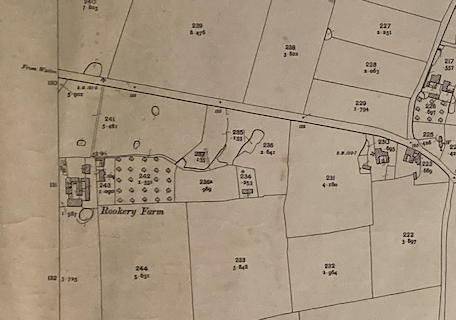
Extract from 1906 Ordnance Survey Map. Second Edition. Surveyed in 1881. Revised 1904.
The origins of the farm may well go back several centuries. However without sight of evidence to support this, I cannot be certain when the present farmhouse was built.
Nevertheless, the house will have undergone many changes over the years. Indeed, Auction Particulars of 1910 mention that the tiled brick and clay farm house had been extended ‘during the last five years’.
Linked Blogs
This is one of several linked blogs looking at the history of Rookery Farm, taking it from the end of the 18th century through to the 20th century.
We begin with the Great Ellingham Inclosure Map of 1802.
1802 Great Ellingham Inclosure Map
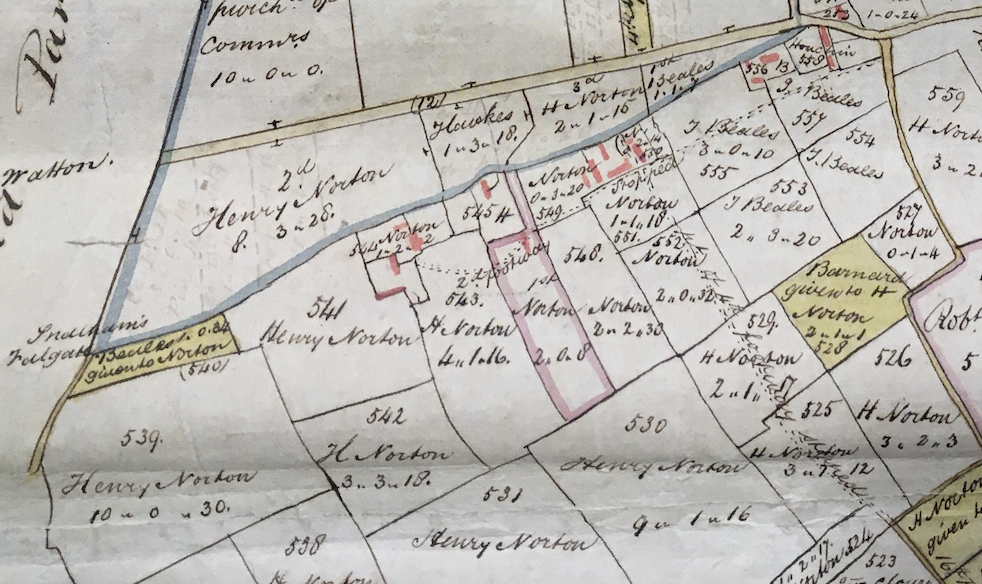
The above extract from the 1802 Inclosure Map clearly shows Henry Norton’s properties coloured red (along side the name ‘Norton’), a short way from the road to Rocklands (which is to the top of the map and shaded yellow).
The blue lines indicate the boundary of Anchor Common, which stretches to the north.
The Statement of Claims c.1799 and the Particulars & Valuation c.1800, also prepared at the time of the Great Ellingham Inclosures, show that Henry Norton and his wife Lydia owned two messuages, one cottage and over 180 acres of land in Great Ellingham.
Henry Norton
At the turn of the 19th century, Henry Norton was one of three significant landowners in Great Ellingham. The other two being Lord Walsingham and the Reverend Francis Colman Negus. None of these three landowners lived in the village.
Baptised in Little Ellingham
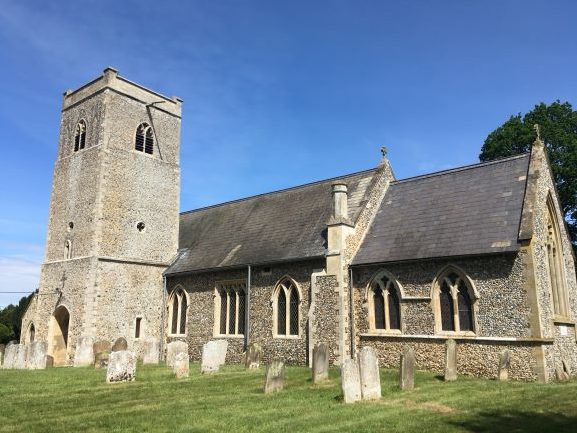
Little Ellingham Parish Church. Photograph taken May 2020
Henry Norton may well be the Henry Norton, son of Jenepe and Mary Norton baptised in the parish church at Little Ellingham on the 27th February, 1747.
Marriage
Around the age of 26, Henry Norton (of Little Ellingham) married Lydia Colman (of Old Buckenham). The marriage took place on the 6th October, 1773, in the same parish church at Little Ellingham.
Purchase of Great Ellingham Farms
I am unclear where Henry and Lydia settled after their marriage. However, they were living in Old Buckenham when Henry Norton purchased the farms in Great Ellingham in 1790.
Copyhold
Although I have not come across title deeds for Henry Norton’s purchase of the farms and land, a small part of the land was copyhold.
With some of the Manor Court Books of Buckenham Castle Outsoken and Buckenham Lathes Outsoken available online, I have been able to establish when Henry Norton purchased the farms and from whom.
Bargain & Sale
The Manor Court Books tell us that Henry Norton produced to each of the Manor Courts a copy of an Indenture of Bargain & Sale dated 6th November, 1790. This deed related to his purchase of property in Great Ellingham previously owned by James Turner.
The parties to the deed were:
1. James Turner, Yeoman, of Great Ellingham. Eldest son and heir of James Turner deceased
2. Thomas Bond & Capel Bringloe, Gentlemen. The Executors of the will of James Turner deceased
3. Joseph Dover, Gentleman, of Dickleburgh
4. Henry Norton, Farmer, of Old Buckenham
5. William Cockell, the Elder, Gentleman, of Attleburgh (Attleborough)
We should bear in mind that the Manor Courts generally only record the transactions in relation to copyhold land. Accordingly, the entry in the Manor Court Book only relates to the copyhold parts of the late James Turner’s messuages, lands, tenements and premises in Great Ellingham.
However, given that the pieces of copyhold land were modest, I have no doubt that Henry Norton purchased the two farms together with the land from the executors for the late James Turner in 1790.
Nevertheless, bearing in mind that James Turner died before the Bargain & Sale was drawn up, it seems that ‘the deal was done’ prior to the death of James Turner.
Great Ellingham Inclosures Award
I also believe that Henry Norton acquired further pieces of land under the Great Ellingham Inclosures Award c.1802.
Death of Lydia Norton
Henry’s wife Lydia Norton nèe Colman died in the May of 1799. She is buried in the churchyard of the parish church at Old Buckenham.
It is more than likely that Lydia Norton is the mother of Henry’s son and heir, William Norton.
Second Marriage
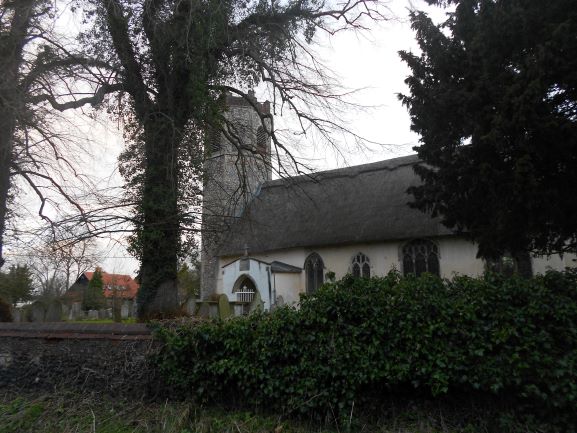
All Saints Church, Old Buckenham
On the 20th December, 1807, widower Henry Norton married spinster Jane Smith at the parish church of All Saints, Old Buckenham.
Death of Henry Norton
Not long before his 85th birthday, Henry Norton died. He too is buried in the churchyard of All Saints in Old Buckenham. His burial took place on the 10th January, 1831.
Henry made provision in his last will & testament with regard to his properties – including his real estate in Great Ellingham.
We look at the provisions of Henry Norton’s last will & testament in a separate but connected blog. In the meantime, we continue to look at the occupiers of the farms.
18th Century Map

Extract from 18th Century Map. Pennell & Anchor Commons in Great Ellingham held at Norfolk Record Office. Cat. Ref. MC2213/114, 941X7 With kind permission of NRO.
The above extract from an 18th century map clearly shows Norton’s properties to the south of the road to Rocklands.
Woodcock’s Farm
The red arrow on the map shows Norton’s farmhouse, barn, stables, yards, garden and orchard which, in 1800, was occupied by Jeremiah Woodcock. Jeremiah also leased some 114 acres of land from Henry Norton.
I believe that this is the farmhouse which later became known as Rookery Farm.
Jeremiah Woodcock
I think it more than possible that the Jeremiah Woodcock who occupied one of Norton’s farms along the Watton Road, is Jeremiah, son of Jeremiah Woodcock, who was baptised in St Andrew’s Church, Hingham on the 21st December, 1748.
A marriage between Jeremiah Woodcock of Hingham and Mary Claxon of Scoulton took place at the parish church in Scoulton on the 19th March, 1770.
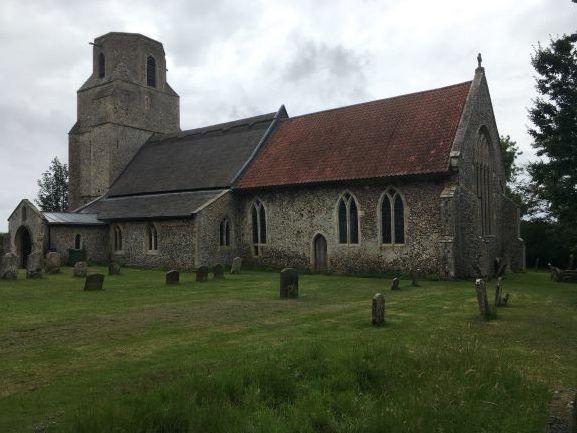
Holy Trinity Church, Scoulton
I found baptisms for five children of the marriage in the parish registers for Scoulton:
| 29th August 1773 | John |
| 25th May 1778 | Jeremiah |
| 2nd June 1784 | Jonathan |
| 4th December 1785 | William |
| 3rd August 1788 | Elisabeth |
Jeremiah and Mary Woodcock were in Great Ellingham by 1791, when they took their son Henry for baptism at St James’s Church on September 18th.
Jeremiah was probably Henry Norton’s first tenant in his farm (the one furthest towards Rocklands).
Day’s Farm

Extract from 18th Century Map. Pennell & Anchor Commons in Great Ellingham held at Norfolk Record Office. Cat. Ref. MC2213/114, 941X7 With kind permission of NRO.
The blue arrow shows Henry Norton’s other property along the Watton Road, comprising a farmhouse, outbuildings, barns, stables, yards, garden and orchard. This farmhouse was occupied by Robert Day together with around 50 acres of land.
In addition, there is a grass pightle with a cottage adjacent to the farm, which was also ‘occupied’ by Robert Day. However, Day sub-let this cottage to an under-tenant. This cottage lies within the parcel of land numbered 549 on the extract from the Great Ellingham Inclosure Map.
I believe the present Rookery Farm Cottages are on this land.
Nathaniel Hawkes’ cottage and a small piece of land separates Norton’s land.
Robert Day
Unfortunately, I have not yet been able to find any particular details about Robert Day. I am wondering whether ‘Day’ was in fact ‘Dey’ (and, subsequently, Dye)?
In any event, by 1817-1819, Robert Day had vacated the farm nearest to the village.
1817-1819
A Survey of Great Ellingham dated 1817-1819, shows that Richard Barnes occupied Norton’s farm nearest the village, which had been occupied by Robert Day.
I have found very little about Richard Barnes. It is possible that Barnes sub-let the farm – or, put a bailiff or agent in to run the farm for him.
Nevertheless, he may be the very same Richard Barnes who married Frances Kerrison in the parish church at Great Ellingham on the 7th March, 1812.
I also found a burial for Richard Barnes in the Baptist Church records for the 24th February, 1825.
The other farm – nearest to Rocklands, was then occupied by William Colman.
It also appears that since 1800, Henry Norton had purchased Nathaniel Hawkes’ cottage with pightle. This is separately let by Norton to Stephen Houchin.
c.1836
By around 1836, both farms were still in the ownership of the Norton family. Indeed, Rookery Farm (comprising most, if not all, of the land purchased by Henry Norton in 1790), remained in the Norton family ownership for the next 70 years.
However, the two farms were tenanted to William Colman, although they may now be one farm.
Given that William Colman lived in Rocklands (and no doubt owned land in Rocklands which was contiguous or near to Norton’s farm), I believe William Colman employed a bailiff to run the farm.
At this time, John Goddard may have occupied the cottage between the two farms. This is the cottage which was formerly occupied by Stephen Houchen (and, before that, by Nathaniel Hawkes).
1840s-1851
William Colman continued to lease Rookery Farm from the Norton family.
Although I do not know for sure who lived at Rookery Farm at the time of the 1841 census, I believe it may have been Colman’s bailiff, local man William Barker
William Colman’s son, William Colman Jnr lived at Haw Farm (Great Ellingham) and another son, James, was at Port Wood (Portwood) Farm.
It certainly seems that by the 1850s, the two farms had amalgamated.
1851 census
The 1851 census captures 70 year widower William Colman at Scoulton Road, Rockland St Peter.
With him is his 24 year old daughter Charlotte, 20 year old son Thomas as well as his 24 year old son James, who is visiting his father with his wife Mary. William’s 3 year old grandson, George Green, is also with the household.
In addition, there is 47 year old widow Hannah Symonds, who is described as a visitor and a nurse, along with 19 year old Anne Cook, who is the family’s general servant.
Death of William Colman
William Colman of Rockland St Peter died at the age of 70 in the late Spring of 1851. He was buried in Attleborough on the 3rd May.
Thomas H Colman takes over at Rookery Farm
William Colman’s son, Thomas Hovell Colman, took over the lease of Rookery Farm. He retained his late father’s bailiff, William Barker, to run the farm.
A notice concerning a sale taking place at Rookery Farm appeared in the Norwich Mercury of the 3rd January, 1857.
“ROOKERY FARM” GREAT ELLINGHAM
Within Two Miles and a half of Attleborough
SALTER AND SIMPSON
Are favoured with instructions to SELL BY AUCTION, on Monday January 5th, 1857,
1,500 CAPITAL LARCH and SCOTCH POLES, many long lengths and large dimensions,
200 OAK, ASH, WILLOW, and ELM POLLARDS,
a quantity of WRONGS, and about 3,000 FAGGOTS.
The above are lying convenient for removal by the side of good roads, on the Farm in the occupation of Mr Thos. H Colman.
Sale to commence at a quarter before Eleven o’clock, in the “Mower’s Mere”, adjoining the Road leading from Ellingham to Rockland.
Catalogues posted free on application
Although the notice suggests that T H Colman ‘occupied’ the farm, Thomas Colman actually lived in Scoulton Road, Rockland St Peter (as he did with his father some 10 years earlier).
Bailiff, William Barker
The 1861 census reveals 82 year old widower William Barker at Colman’s Farm, Great Ellingham. Given that William Barker is described as a farming bailiff, I have no doubt that he is working for Thomas Hovell Colman at Rookery Farm. Further, I think it more than likely that Barker had been Colman’s bailiff for a number of years.
With William is his 40 year old unmarried son Henry (who is described as an agricultural labourer), 20 year old William Riches and 18 year old John Houchen, who are described as ‘servants’ and team-men. Accordingly, it follows that Henry Barker, William Riches and John Houchen are all working on the farm for William Barker – and, in effect, Thomas Hovell Colman.
Completing the household is 18 year old Emily Chestnut, a servant keeping house for William Barker, as well as a visitor, 72 year old widow Elizabeth Button.
Born in Great Ellingham

Church of St James, Great Ellingham
Born in Great Ellingham c.1779, William Barker married Phoebe Thurston in St James’s Church, Great Ellingham on the 23rd December, 1811.
The couple had at least two sons – Richard born c.1812 and Henry born c.1821. I believe they were both born in Great Ellingham.
1841 census
In 1841, William and Phoebe together with their son Henry lived in Great Ellingham. Given that the 1841 census gives William’s occupation as an agricultural steward, I think it more than possible that he was employed by William Colman to manage the Rookery Farms (or Farm).
Phoebe Barker died at the age of 65 during the summer of 1846.
1851 census
Widower William Barker remained living in Great Ellingham. The 1851 census captures William with his son Henry living in Great Ellingham. However, even though the census lists William Barker’s household as being in ‘Bow Street’, I believe William and his son were at Rookery Farm.
Death of Bailiff, William Barker
Some four years after the 1861 census, William Barker (who for many years was employed by the Colman family as their bailiff at Rookery Farm), died at the age of 85.
His last will & testament was proved by local builder, William Lebbell.
Bailiff, Henry Barker
In 1871, Colman’s Farm is occupied by Attleborough born 26 year old Henry Barker and his wife Charlotte. The couple have two children – 3 year old Charles Richard and one year old John Herbert.
Henry Barker is a grandson of Colman’s former farm bailiff William Barker. I have no doubt that Thomas H Colman now employs Henry Barker as his bailiff at Rookery Farm. 65 year old Joseph Le Grice is working for Henry Barker on the farm.
By 1881, Henry Barker had left Colman’s Farm. The 1881 census finds Henry with his second wife Ellen and children in Old Buckenham – not far from his parents, Richard and Martha Barker.
Bailiff, Isaac Drake
The first reference I have found to the name ‘Rookery Farm’ is in the census of 1881.
The census shows 33 year old Isaac Drake with his wife Mary Ann (also 33) and children Sophia 9, Alice 6 and three year old Amelia at Rookery Farm. 30 year old agricultural labourer Daniel Bales (Beales) is lodging with the family.
Isaac Drake is Thomas Colman’s farm bailiff. The move to Rookery Farm as Colman’s bailiff will have been a ‘step up’ for Isaac. Ten years earlier, the 1871 census finds agricultural labourer Isaac with his wife Mary living in Scoulton Road, Rockland St Peter.
Occupants of Rookery Farm Cottages
Two other households are listed at ‘Rookery Farm’:
83 year old farmer’s widow, Phillis Wright is with her two granddaughters – 23 year old Ellen S Wright and 15 year old Sarah B Wright. Ellen is keeping house for her grandmother.
Next door 70 year old widower William Curson is with his 25 year old daughter Lydia Curson. William Curson is working as a labourer – presumably for Isaac Drake, and Lydia is working as a needlewoman.
I have no doubt that the households of Phillis Wright and William Curson are at Rookery Farm Cottages, which by then were on the land which some 80 years earlier, was occupied by Robert Day.
1891 census
Ten years later, Isaac Drake is still employed by Thomas Colman as his bailiff at Rookery Farm. In turn, Colman continues to lease the farm from the Norton family which, by then, is headed by Henry Norton’s grandson, Henry Norton.
Isaac and Mary Drake now have four children with them – 19 year old Sophia, 7 year old Samuel William, Martha aged 5 and six month old James.
The Drake’s lodger, Daniel Beales, is still with the family.
Occupants of Rookery Farm Cottages
The census records 56 year old widower William Turner at ‘Rookery House’. I assume ‘Rookery House’ to be Rookery Cottages – perhaps the cottages were occupied as one dwelling? Attleborough born Turner is a retired carpenter. He has 15 year old Rosine Markwick keeping house for him.
Link with the Past?
With a little investigation, it appears that William Turner’s full name is William Earsham Turner. Given that the name ‘Earsham’ was used by the Turner family who lived in Great Ellingham during the 18th century, I wonder whether William Turner is descended from James Turner – who sold the farms and land (which later became Rookery Farm) to Henry Norton over a century earlier!
Moving forward into the next Century
At the end of the 19th century, the custodian of Rookery Farm was William Joseph Norton, the great grandson of Henry Norton, who purchased the farm (then two) from James Turner in 1790.
By 1901, Rookery Farm and Rookery Farm Cottages had new occupants. Further, within the next ten years, the Norton family’s ownership came to an end.
Sources:
1802 Russell James Colman Plans. Great Ellingham. Norfolk Record Office. Catalogue Ref. C/Ca 1/84.
1799-1842 F W Horner, Records of the Surveyors to Commissioners for Inclosure in Parishes in Norfolk and Suffolk. Great Ellingham (Act 1799). Norfolk Record Office. Catalogue Ref: NRO, BR 90/2
1800 Inclosure Commissioner’s Particulars and Valuation, Great Ellingham. Norfolk Record Office. Catalogue Ref: NRO, MC 2213/119
1799 Statement of Claims. Great Ellingham Inclosure. Norfolk Record Office. Catalogue Ref: MC 2213/118
18th Century Map. Town Green, Hyrne and Broad Commons in Great Ellingham held at Norfolk Record Office. Cat. Ref. MC2213/113, 941X7
Great Ellingham Parish Registers & Archdeacon’s & Bishop’s Transcripts. Norfolk Record Office PD 609. Also available via www.familysearch.org & www.ancestry.co.uk
1753-1847 Manor of Buckenham Castle, Lathes, Close and Priory. Court Book. Norfolk Record Office. Catalogue Ref: MC 1833/8 -MC 1833/16. 1595-1847 also available at https://www.familysearch.org
1910. Auction Particulars September 8th, 1910. The Rookery Farm, Great Ellingham. ‘The Attleborough & District Historian’ Issue No.31. January/February 2017. Editor David True. Copy courtesy David Ewin
Little Ellingham Parish Registers. Norfolk Record Office PD 568. Viewed via www.ancestry.co.uk
Old Buckenham Parish Registers & Archdeacon’s & Bishop’s Transcripts. Norfolk Record Office PD 107. Viewed via www.ancestry.co.uk
Henry Norton. Probate of Will 14 October 1831. England & Wales, Prerogative Court of Canterbury Wills, 1384-1858. The National Archives; Kew, Surrey, England; Records of the Prerogative Court of Canterbury, Series PROB 11; Class: PROB 11; Piece: 1791a. Ancestry.com. England & Wales, Prerogative Court of Canterbury Wills, 1384-1858 [database on-line]. Provo, UT, USA: Ancestry.com Operations, Inc., 2013.
Scoulton Parish Registers & Archdeacon’s & Bishop’s Transcripts. Norfolk Record Office PD 366. Viewed via www.ancestry.co.uk and FreeReg website
Hingham Parish Registers. Norfolk Record Office PD 575. Viewed via www.ancestry.co.uk and FreeReg website
Attleborough Parish Registers. Norfolk Record Office. PD 438. Viewed via www.ancestry.co.uk
1841 census. Great Ellingham. HO107/781/8
1851 census HO107/1823/265, HO107/1823/114
1861 census RG9/1237/85, RG9/1238/97
1871 census RG10/1841/79, RG10/1842/95
1881 census RG11/1971/57, RG11/1974/82
1891 census RG12/1549/71
Norwich Mercury 3rd January 1857 viewed via The British Newspaper Archive
GRO Index. https://www.gro.gov.uk/gro/content/ also available via FreeBMD website
England & Wales, National Probate Calendar (Index of Wills & Administrations(, 1858-1995. William Barker. Death Date 13 August 1865. Probate 4th September 1865. Principal Probate Registry. Calendar of the Grants of Probate and Letters of Administration made in the Probate Registries of the High Court of Justice in England. London. Ancestry.com. England & Wales, National Probate Calendar (Index of Wills and Administrations), 1858-1995 [database on-line]. Provo, UT, USA: Ancestry.com Operations, Inc., 2010.